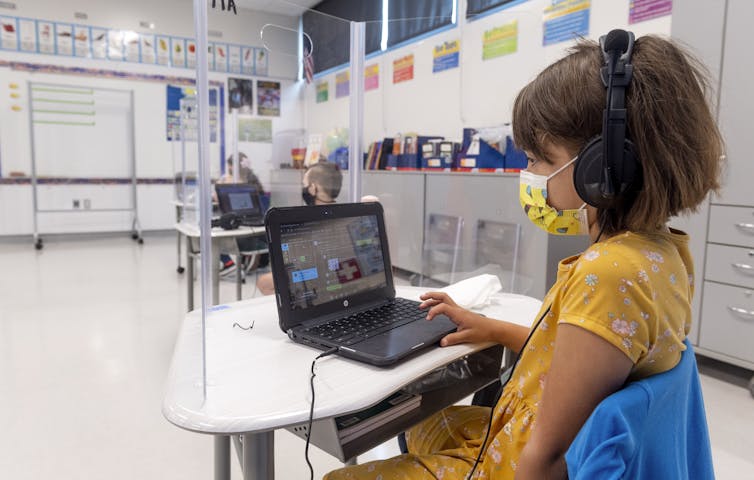
Stephen Sireci, University of Massachusetts Amherst
The standardized tests given to children in schools today are a lot different from those their parents might remember.
For example, students today might take a standardized test at home on a laptop or other digital device. That test is more likely than before to incorporate content on diverse cultural heritages. And students taking a test may not even be aware they are being assessed, as more tests are blended with instruction.
As a psychometrician who has designed, evaluated and researched educational tests for over 25 years, I believe this new era of school testing is a great improvement. It means tests have more potential to facilitate student learning, rather than just monitor learning or penalize students. And it shows that, after years of growing public distrust in educational testing, standardized tests are no longer just tools for accountability – the public is now holding test makers accountable.
Here are six ways standardized tests are evolving.
1. Less common in admissions
The federal No Child Left Behind Act of 2001, and its successor, the Every Student Succeeds Act of 2015, require states to periodically test all students in grades 3-8, and once in high school, in math, reading and science. These mandated tests are used to evaluate teachers and assign performance labels to children, such as “inadequate” or “minimal understanding.”
The “opt-out” movement, in which parents and their children organized and refused to take these tests, arose in response. As a result, over a dozen states in 2015 did not meet the federal requirements to test at least 95% of students.
High school and college admissions tests have also been targets of criticism and are declining in use.
In 2020, the University of California decided to phase out ACT and SAT testing requirements due in large part to the impact these scores had on denying admissions to Black and Hispanic students. Similar complaints surround admissions tests for competitive high schools. For example, a March 2021 lawsuit against New York City and the state claims that the high school admissions process “denies equal opportunity and protection to students of color.”

2. Taken at home on different devices
For over a century, standardized tests involved students seated at desks in front of a proctor watching the clock. The tests were administered under stringent conditions to ensure all students were tested on the same content and under the same testing conditions.
The COVID-19 pandemic changed that and made it nearly impossible to administer educational tests in classrooms or other school settings. This prompted more flexible tests. In 2020, students began taking high-stakes tests such as Advanced Placement, the Graduate Management Admission Test and statewide exams at home. Some tests require a proctor to watch students via their computer’s camera, or they use additional software to flag suspicious behavior that may indicate cheating.
3. Integrated with other education software
The COVID-19 pandemic prompted an emphasis on technology to not only deliver tests digitally and remotely, but to also integrate them with a wide array of instructional software.
One familiar example of such integration is the Duolingo app, which teaches foreign languages by constantly testing users. Testing companies are also partnering with curriculum companies so that the results from tests can be used to suggest what students and teachers should focus on next. Other developments use technology to assess students while they are learning. This integration makes the tests more useful because teachers and learners can benefit from more tailored instruction, or instruction embedded in the assessment itself.
4. Recognize cultural diversity of students
The new generation of educational tests are beginning to reflect more diverse material to which students from different groups can relate.
For instance, a test today might mention topics like the Black Lives Matter movement or immigration reform to acknowledge the presence of racism in society and honor students’ cultural heritages.
5. More personalized
More tests are using technology to personalize assessments and encourage student engagement. For example, the difficulty of the test can change based on how well students are doing while they take it. And new research funded by the U.S. Department of Education aims to transform tests so teachers, employers and students can design their own tests for specific purposes such as diagnosing student needs.
6. Emphasize learning over competition
Finally, the new tests will deemphasize comparing students to one another and instead highlight the knowledge and skills students have demonstrated, in addition to pointing out what they should work on.
Moreover, new tests being designed will not interrupt instruction – they will be part of it. To best inform learning and instruction, shorter tests, targeted to recent instruction, will be administered, and students’ performance will be reported quickly. Teachers will be guided on how to use the results to inform and improve their instruction.
By incorporating technology to engage students and integrate testing with instruction, and by making test materials relevant to a wider diversity of students, I believe the new educational tests will better serve education.
[Get the best of The Conversation, every weekend. Sign up for our weekly newsletter.]![]()
Stephen Sireci, Professor of Psychometrics, University of Massachusetts Amherst
This article is republished from The Conversation under a Creative Commons license. Read the original article.
The views and opinions expressed in the article are solely those of their authors, and do not necessarily reflect the opinions and beliefs of AcademicWomen.com.
